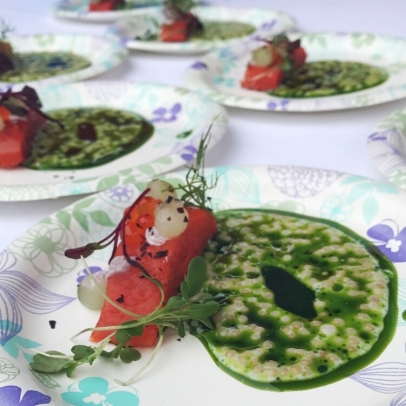Will establishing the Arctic as its own food region save the culture? These chefs hope so.
When asked to name German foods, most people would say bratwurst, pretzels, schnitzel, and beer. Southern food would elicit responses like fried chicken, grits, collard greens, and barbecue.
But what about Arctic food? As it turns out, there aren’t any easy answers. A group of Arctic chefs and academics is trying to change that.
The inaugural North by North festival was a four-day series of events in Anchorage focused on Arctic music, arts, culture — and of course — food. The festival came on the heels of the annual meeting of the international Arctic Council, held in Fairbanks this year, where the U.S. formally handed off the rotating chairmanship to Finland.
During NxN’s demonstrations and talks, groups of artists, scholars, and government officials from the world’s northern reaches discussed the future of the region and its culture.
“We have an agreement with the leadership of Alaska and leadership of the United States; there is one Arctic. We should work for the cooperation and understanding between states and countries — likewise the food, I believe,” said Svein Mathiesen, a professor from Sámi University College and the Norwegian School of Veterinary Science.
Mathisen is also an employee of the International Centre for Reindeer Husbandry who has been involved with international cooperation in the field of reindeer husbandry for nearly two decades and was part of creating a new book about Arctic culinary traditions and indigenous food culture. Twenty-four nations currently have programs for the cultivation and breeding of reindeer, he said, including the U.S.
If things are going so well, why are people bothering to talk about it?
Because the Arctic is changing.
Coca-Cola can be found in far reaches of the region and modernization has created a culture of waste. The system is broken, Mathiesen said, citing numerous occasions he's witnessed when more than half of an animal harvested was thrown away.
Chef Viktor Örn Andrésson from Iceland said the financial crisis in Europe has reinvigorated traditional Icelandic food preparations. Dishes like blood sausage and smoked sheep’s head can be found in restaurants and fish skin wallets found in local shops.
“Before the crisis, we were importing zebra and meat from Australia, but on the menu you couldn’t see Icelandic local things, just things from other parts of the world,” Andrésson said. “But after the crisis, we have looked at what we have around us and in Iceland, it’s like it’s opened up a new door.”
For Alaskan Aaron Apling-Gilman, executive chef at the Seven Glaciers at Alyeska Resort, foraging is as much part of the Arctic culinary tradition as regional meats. For this harder cuisine, chefs are using modern techniques to coax flavors out of harsh ingredients. It’s tough work, he said, to refine them in a way to make them palatable for a range of tastes.
Some of that responsibility falls to the consumer, he said. Mathiesen agreed, but said it’s incumbent on chefs to be the catalyst.
“We have to push the fork,” Mathiesen stated, saying chefs ought to spotlight Arctic flavors in their restaurants and stressing the economics of sustainable practices. “I believe that’s the key to preserve traditional knowledge and the food culture — that you’re eating traditional dishes in the restaurants.”
Chef Nikolay Gabyshev is a success story in this regard. From the Sakha Republic in Russia, Gabyshev is the executive chef at Muus Khaya in Yakutsk, specializing in local horse meat and fish. His eatery also serves moose milk, he explained using a translator. To continue to use these unique foods, you have to market them through the kitchen, he said.
Gabyshev explained that owner Yegor Makarov, who was also in attendance during the discussion, does much of the leg work to educate people about the local foods Muus Khaya has on its menu. In turn, the locally sourced ingredients give chefs more opportunity, Gabyshev said.
All four experts on the panel agreed that diners across the region are seeking out locally grown food products. But while the international chefs have wild game at their disposal, state regulations stop Alaska chefs from being able to serve wild meats like caribou and moose in their restaurants.
But even if they could serve it, would customers want it? Andrésson said in Iceland the old recipes to make use of the internal organs and less popular cuts of meat don’t sell as well and that the mindset of the eater needs to change.
So the fate of food culture lands back with the chefs, Mathiesen said.
“It’s important in your restaurant to preserve the culture of food and the biodiversity of the raw material,” he said. “It’s also your responsibility.”




